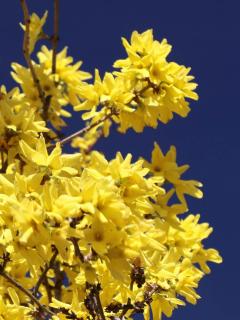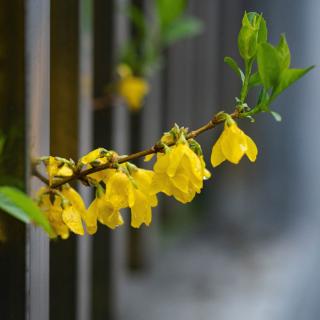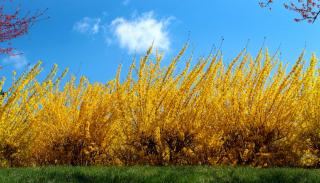

Forsythia is truly marvelous in spring thanks to its magnificent golden flowers.
Forsythia facts
Name – Forsythia intermedia
Family – Oleaceae
Type – shrub
Height – 6 to 10 feet (2 to 3 meters)
Exposure – full sun and part sun
Soil – ordinary, not too chalky
Foliage: deciduous – Flowering: early spring – Special feature: Very hardy
Caring for forsythia is easy, from planting to pruning, and every bit of attention goes towards helping the growth and bloom of your plant.

Even though it is known to be hardy (it resists to the coldest temperatures in its native Western Europe), root development will be at its best with proper planting.
It is also possible to grow forsythia in a pot on a terrace or balcony, but prepare to repot every 2 or 3 years.
An easy plant to care for, you won’t have any chores to go about with your Forsythia once it’s properly settled in.
It helps to water after planting, for a whole year.
After that, you’ll only have to water if it’s in containers or pots.

You can prune it severely, if need be.
Only one rule if you want to have flowers in the following year:
Prune just after the blooming!
Cut it back as much as you wish, trying to keep the shape as appealing as you can.
The Forsythia shrub is extremely hardy and resists diseases very well.
Most problems you’ll ever get can probably be traced back to improper care.
Check that it isn’t exposed to scorching hot sun, that it doesn’t lack water, or that the soil is soggy for too long after rains.
Forsythia, or Border Forsythia, is famous for its sparkling yellow blooming at the beginning of spring. Note that more and more stores offer a beautiful alternative to yellow, the white forsythia.

Landscapers often showcase Forsythia as a standalone, but this shrubs also does well in flower beds or flowered hedges. Beautiful varieties include the ‘Karl Sax’ and the ‘Lynwood’
→ Read also: Pruning shrubs and trees
Feel free to spread mulch to protect roots from the cold, avoid weed growth and provide the soil with the organic matter it needs.